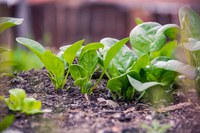Dakota Gardener: Cool-season Garden Crops
(Click an image below to view a high-resolution image that can be downloaded)
By Carrie Knutson, NDSU Extension Agent, Grand Forks County
I was itching to get into the garden this year.
The soil was dry and the weather was nice, but the calendar showed it was still a bit too early. Then Mother Nature provided us with a second winter and reminded me to have patience.
I am grateful for the moisture, even if it is in the form of snowflakes. Now I am more confident about getting in the garden. I am going to take advantage of the weather by direct seeding some cool-season crops.
Cool-season crops can tolerate cold temperatures and are seeded two to four weeks before the last frost. Typically, our last spring frosts are mid-May. Examples of cool-season crops are broccoli, beets, cabbage, kohlrabi, kale, lettuce, Swiss chard, carrots, radish, spinach, turnips and onion. Seeds of these plants will germinate at cool soil temperatures, around 40 to 50 F.
Check your seed packets for information on early seeding. Usually seed packs will list minimum soil temperatures or times for direct seeding outdoors. For example, my spinach seed packet says to direct sow when soil temperatures reach 45 F.
How do you know what your soil temperature is? You can find that out by using a soil thermometer or an online tool.
Soil thermometers can be purchased from various sources. To measure the soil temperature, push the thermometer into the soil to the depth you want to seed.
Air temperatures and the amount of sunlight impact soil temperatures. So take temperature readings at several locations and for several days in your garden to determine an average soil temperature.
The North Dakota Agricultural Weather Network (NDAWN) has an online tool that gardeners can use to determine local soil temperatures. Deep soil temperatures are listed under weather data and range from 2 to 89 inches.
For example, on April 15 at 8 a.m., the soil temperature at the 2-inch depth at the Grand Forks station was 33 F and at the Dickinson station it was 40 F. The NDAWN site can be found at https://ndawn.ndsu.nodak.edu/. It is a great site to explore for other weather-related information.
Some cool-season crop seed can be seeded mid-summer for a fall harvest. Examples are radish, lettuce, spinach and turnips. These crops must be planted with enough time to grow and mature before the weather turns cold.
Use the “days to maturity” listed on the seed packet to help you figure out when to start the seed. Usually seeding the crops mid-July or early-August works well. If we do get an early frost, plants can be covered to lengthen the growing time. I have had success with spinach and leaf lettuce in my garden.
Warm-season crops like warm weather and do not tolerate frost, or cold soil temperatures or weather. They should be transplanted after the danger of frost has passed. Examples are tomatoes, peppers, zucchini, eggplant, squash, melons and cucumbers.
I ran out of room on my dining room table for seed starting. I guess we need to have some room to eat. So I am going to seed some bok choy, spinach, kohlrabi and kale in my garden. Happy gardening!
For more information about gardening, contact your local NDSU Extension agent. Find the Extension office for your county at https://www.ag.ndsu.edu/extension/directory/counties.
NDSU Agriculture Communication - April 20, 2021
Source: Carrie Knutson, 701-780-8229, carrie.knutson@ndsu.edu
Editor: Ellen Crawford, 701-231-5391, ellen.crawford@ndsu.edu




